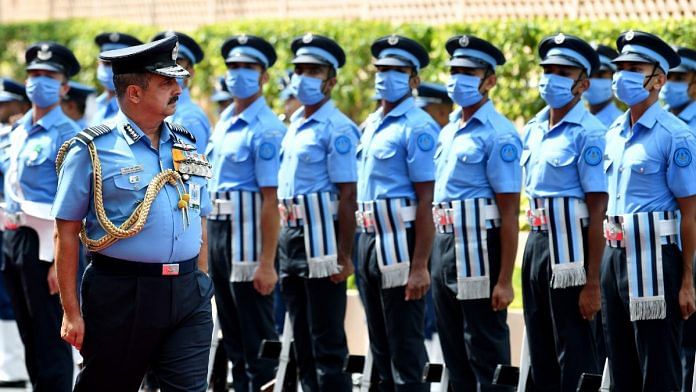New Delhi: Seasoned fighter pilot Vivek Ram Chaudhari, who oversaw India’s aerial response to China’s aggression at the Line of Actual Control (LAC) in eastern Ladakh, Thursday took over as the chief of the Indian Air Force from Air Chief Marshal R.K.S. Bhadauria following the latter’s superannuation.
Air Chief Marshal Chaudhari, who is now the Chief of Air Staff (CAS), is among the few military chiefs — in the Army, Navy or the Air Force — to take over as chief when their child is in the service as well. His son is a Rafale fighter pilot.
Earlier, Air Chief Marshal N.A.K. Browne (Retd) had his son serving in the IAF when he was the chief (2011-2013).
Also Read: There’s more to IAF than just being ‘supporting arm’, CDS & Chiefs must make a fresh start
Flier, instructor, aerobat
Born on 4 September 1962, Air Chief Marshal Chaudhari was commissioned into the fighter stream of the IAF on 29 December 1982.
An alumnus of the National Defence Academy, the air officer takes over as chief at a time when the IAF is in the midst of a massive modernisation drive and grappling with a depleting fighter squadron strength.
The officer has flown several types of aircraft, including MiG-21, MiG-23 MF, and MiG-29, and has racked up over 3,800 flying hours.
Since July, he had been serving as IAF vice-chief, a position he took after a nearly-year-long stint heading the critical Western Air Command.
He was the member of the first aerobatics team Surya Kiran — which pulls off dazzling displays of heart-stopping mid-air manoeuvres — and is a CAT-A qualified Flying Instructor, a graduate of the Defence Services Staff College, Wellington (Tamil Nadu), and an instrument rating instructor and examiner.
He has commanded a MiG-29 squadron and also served as chief operating officer (COO) of an operationally active base. His roles have included a stint as commander of a crucial IAF base.
As Air Vice Marshal, Chaudhari served as deputy commandant at the Air Force Academy, assistant chief of air staff operations (air defence), and assistant chief of air staff (personnel officers).
Other roles include deputy chief of air staff at Air HQ, which deals with modernisation and acquisitions, and senior air staff officer at the Eastern Air Command.
Depleting fighter strength a concern
One of the big challenges that the new IAF chief will have to deal with is the depleting fighter aircraft squadron strength.
At present, the IAF is down to 30 squadrons, as against a sanctioned strength of 42.
While the IAF has ordered 83 LCA (light combat aircraft) Mk-1A, it faces more shortage in the future as four squadrons of the MiG-21 Bison are set to be de-commissioned by 2025, followed by those of the Jaguar aircraft. The Mirage 2000 and MiG-29 squadrons will also be phased out over the next two decades.
According to the IAF’s own projections from 2019, even if all existing orders for 36 Rafales, six squadrons of Tejas (including Tejas Mark-1A) and two more squadrons of Sukhoi Su-30MKI are taken into account, the squadron strength will reduce to 27 by 2032 and a mere 19 by 2042.
Even if one takes into account the induction of Tejas Mk-2 (still in design phase), 114 new fighters (a decision on this project is yet to be taken), and the indigenous Advanced Medium Combat Aircraft (still in design phase), the IAF is unlikely to reach its sanctioned strength of 42 squadrons by 2042.
The last time the IAF had 42 squadrons was in 2002.
(Edited by Sunanda Ranjan)
Also Read: Air Marshal Chaudhari knows the mess IAF is in. Must push the govt for more fighter aircraft



